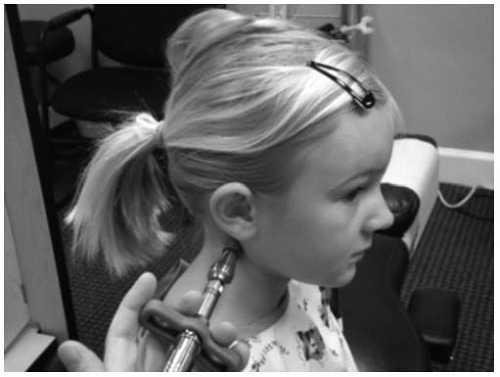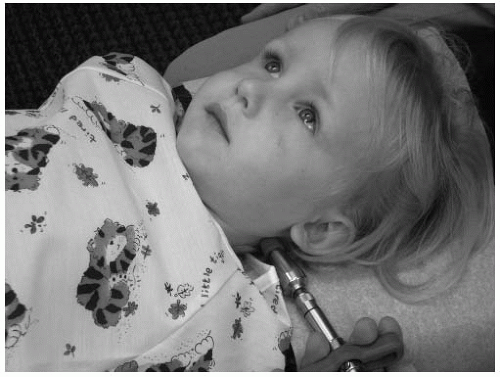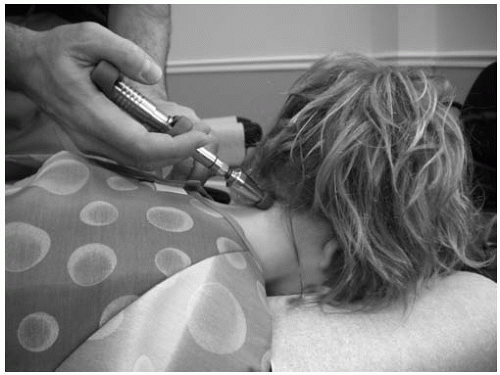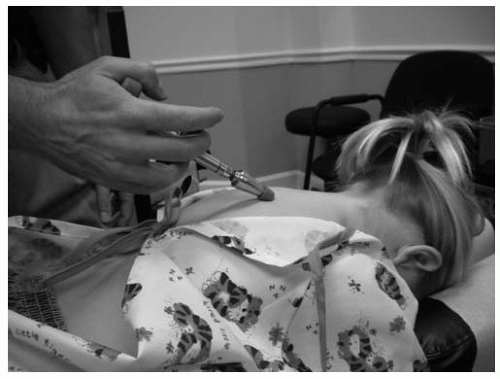Pediatric and Prenatal Instrument-Based Adjusting
Drew G. Rubin
This chapter will focus on the Activator adjusting instrument (AAI) (1). There are several other instrument-based adjusting techniques available to the chiropractor.
In a review by Fuhr and Menke (2), 13 case studies cited the apparent efficacy of the AAI in the treatment of a variety of conditions. The case studies indicated effectiveness with cervical and lumbar disc herniation: shoulder, heel, and knee pain; otitis media; and Bell’s palsy (2). The author will present a brief overview of the use of instrument-based adjusting among the prenatal and pediatric populations.
THE PEDIATRIC PATIENT
In general, for newborns to juveniles, the Activator II instrument may be more comfortable because of the lack of pre-load, as is the case of the Activator IV. It is important always to dampen the adjustment with your finger on all thrusts until the age of 2 years. Depending on the child’s preference, he or she can be adjusted in the prone, supine, or side-lying positions. He or she can also be held by a parent or placed on a pregnancy pillow.
CERVICAL AND THORACIC
Seated Atlas ASR (+Z, -θX, -θZ, -X)
Contraindications: all other listings, normal functional spinal unit, instability, destruction or fracture at or near the area to be adjusted, transverse ligament rupture, spinal infection in the area to be adjusted (Fig. 29-1)
Patient position: sitting on the chiropractic table or the parent’s lap facing the doctor, depending on patient comfort
Doctor position: either standing on the side of the atlas laterality or seated on a stool facing the patient with the other hand stabilizing the side opposite contact (not shown)
Contact site: the right atlas transverse process
Adjusting instrument contact: among patients younger than 2 years old, the tip of the adjusting instrument is on top of doctor’s fingertip (not shown in figure). Among patients younger than 2 years old, contact depends on the sensitivity of the child
Pattern of thrust: lateral to medial to reduce misalignment.
Force of thrust: Activator II = one ring; Activator IV = setting 1
Supine Atlas ASL (+Z, -θX, +θZ, -X)
Patient position: supine
Doctor position: either standing on the side of the atlas laterality or seated on a stool facing the patient with the other hand stabilizing the side opposite contact (not shown)
Contact site: the left atlas transverse process (Fig. 29-2)
Adjusting instrument contact: among patients younger than 2 years old, the tip of the adjusting instrument is on top of the doctor’s fingertip (not shown in figure) Among patients younger than 2 years old, the contact depends on the sensitivity of the child
Pattern of thrust: lateral to medial to reduce the misalignment
Force of thrust: Activator II = one ring; Activator IV = setting 1
Prone C2 PL (-Z, -θY)
Contraindications: all other listings, normal functional spinal unit, instability, destruction or fracture at or near the area to be adjusted, spinal infection in the area to be adjusted (Fig. 29-3)
Patient position: lying prone with or without a pregnancy pillow on an adjusting table, or seated on a table or on a parent’s lap
Doctor position: either standing to the side of the patient or seated on a stool at the head of the table Contact site: inferior aspect of the right lamina pedicle junction
Adjusting instrument contact: among patients younger than 2 years old, the tip of the adjusting instrument is on top of the doctor’s fingertip (not shown in figure). Among patients younger than 2 years old, the contact depends on the sensitivity of the child
Pattern of thrust: posterior to anterior, inferior to superior, slightly lateral to medial
Force of thrust: Activator II = one ring; Activator IV = setting 1
Prone T6 PL (-Z, -θY)
Contraindications: all other listings, normal functional spinal unit, instability, destruction or fracture at or near the area to be adjusted, spinal infection in the area to be adjusted
Patient position: lying prone with or without a pregnancy pillow on an adjusting table (Fig. 29-4), or is seated on the adjusting table or on the parent’s lap (Fig. 29-5)
Doctor position: standing to the side of the patient’s high transverse process
Contact site: inferior aspect of the right transverse process
Adjusting instrument contact: tip of the adjusting instrument
Stay updated, free articles. Join our Telegram channel

Full access? Get Clinical Tree






